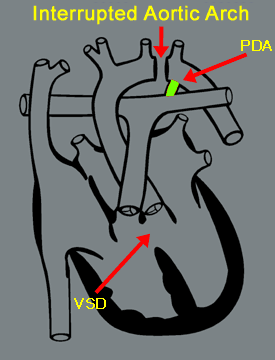 (rollover to compare with normal)
(rollover to compare with normal) |
|
What Are Its Effects?
An infant with this anomaly is usually quite sick immediately after birth.
If steps are not taken to keep the Patent Ductus Arteriosus (PDA) open, no oxygen will make its way to the lower body tissues and the patient will go into shock.
Interrupted aortic arch usually occurs with other cardiac anomalies, such as ventricular septal defects, patent ductus arteriosus, transposition of the great arteries, aortic stenosis, truncus arteriosus, bicuspid aortic valve, and atrioventricular canal defects. The prognosis and treatment for the patient with IAA will be affected by the presence of any associated defects.
Interrupted aortic arch is commonly seen as a result of a genetic chromosomal microdeletion (chromosome 22q11), often referred to as DiGeorge syndrome. Patients with DiGeorge syndrome can have cranio-facial, immune and electrolyte abnormalities in addition to their congenital heart disease. Patients with interrupted aortic arch are evaluated by a geneticist to determine if they have DiGeorge syndrome. |